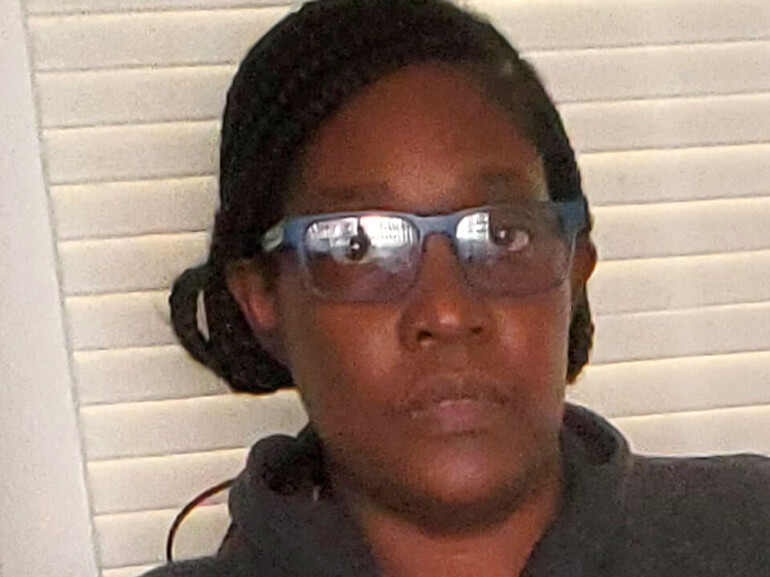Colleen's story

In 1995, Colleen Campbell experienced a personal life-changing event when she moved to the United States from Jamaica. Twenty-five years later, she experienced a medical life-altering event when she suffered a severe stroke at the young age of 45. A mother of three children, ages 13, 20 and 24, the full-time surgical technician and medical assistant was living a busy, independent life. She enjoyed cooking, taking day trips with her children and riding the train between Pennsylvania and New York.
Then, her whole world changed in an instant. Colleen was playing a game on her phone before falling asleep when the room suddenly started to spin. When Colleen tried to sit upright, she was unable to do so and kept falling onto her left side. She called out to her daughter for help. Her daughter called 911, and the ambulance took Colleen to the emergency department at UPMC Pinnacle Community Osteopathic Hospital.
In the emergency department, Colleen had a CT scan of her brain and neck. She received tPA, a drug used to break up clots. In addition to continued dizziness, Colleen experienced slurred speech and progressive weakness on the left side of her body. Due to the severity of her condition, she was admitted to the ICU. There, an MRI revealed reduced blood flow to the left side of her brain. Her condition continued to decline. She had a tube placed into her trachea to protect her airway, and she received steroids. After a consult with neurosurgery, Colleen was transferred to the ICU at UPMC Pinnacle Harrisburg, where they were better equipped to manage her condition.
Colleen spent 13 days in the ICU, where she had excess cerebrospinal fluid drained from her head. Once stabilized, her breathing tube was removed; however, she still required a feeding tube due to her inability to swallow. As she became more stable, Colleen was ready to transfer out of the ICU. She selected Helen M. Simpson Rehabilitation Hospital for the next step in her recovery.
Her short-term goals upon admission were to walk again and independently complete self-care tasks. Her long-term goals were to drive, return to work and be able to travel with her children. During Colleen’s time at Helen M. Simpson, she underwent intensive physical therapy, occupational therapy and speech therapy to assist her in achieving these goals.
Colleen foggily remembers her first few days of rehabilitation. The stroke impacted her ability to sit upright and move the right side of her body. On her first day of physical therapy, Colleen needed three people to assist her in a standing device. She could not lift her arms to pull herself up or control her trunk once she was standing. By the fifth day, she was standing with only two people and had improved control of her trunk. In the coming days, Colleen worked on strengthening her legs and arms in therapy. As she regained her strength, movements became more coordinated, and she was able to sit unsupported by others. This was a big accomplishment. Colleen also practiced standing multiple times per session to extend endurance. Once she could stand for several minutes, Colleen began gait training in the parallel bars.
The turning point in Colleen’s recovery is when she took her first steps between the parallel bars. It was in that moment, she truly believed that she would be able to walk again. Initially, her knees would buckle and her trunk would collapse forward, but each day she increasingly improved walking with increased confidence. Over time, Colleen was able to walk with a rolling walker.
When Colleen first arrived, she had issues with her vision and required a significant amount of assistance for all self-care tasks and functional use of her arms. Transferring from a bed to a wheelchair required the use of a standing frame and assistance of three people. Colleen was highly motivated to improve, pushing herself during each occupational therapy session. To address her visual deficits, she participated in training sessions while wearing optical prisms. Unable to sit upright unsupported, Colleen worked on her core stability by completing strengthening and dynamic reaching exercises while seated on the edge of a mat table. Because Colleen had little control over the movement in her arms, she completed a variety of fine motor tasks and hand-eye coordination activities. She also learned how to use adaptive equipment to increase her independence in self-care tasks, such as bathing and dressing.
Colleen also worked with speech therapists with a goal of eating a normal diet again. She arrived with a feeding tube from the ICU and had vocal cord paralysis. Her therapists used neuromuscular electrical stimulation to re-educate the muscles used for swallowing. She also participated in exercises to strengthen the muscles utilized in coughing, swallowing and breathing. Over time, Colleen was able to consume a regular solid and thin liquid diet. She also improved her vocal strength and intensity.
Colleen credits her children with being a significant source of support and motivation for her. Although she was not able to see them in-person due to COVID-19 visitation restrictions, she video chatted with them each day. They also completed two sessions of family training to ensure that both Colleen and her family were well prepared for her to discharge home safely with a strong support system in place.
One other thing that kept Colleen motivated was her desire to be home for her 46th birthday. She received an early birthday present and returned home with four days to spare. At the time of her discharge, Colleen was able to feed herself and brush her teeth independently. She was able to bathe, go to the bathroom and dress with minimal assistance and was walking 142 feet with a rolling walker. Colleen needed a wheelchair for discharge, but said she would not need it for long!